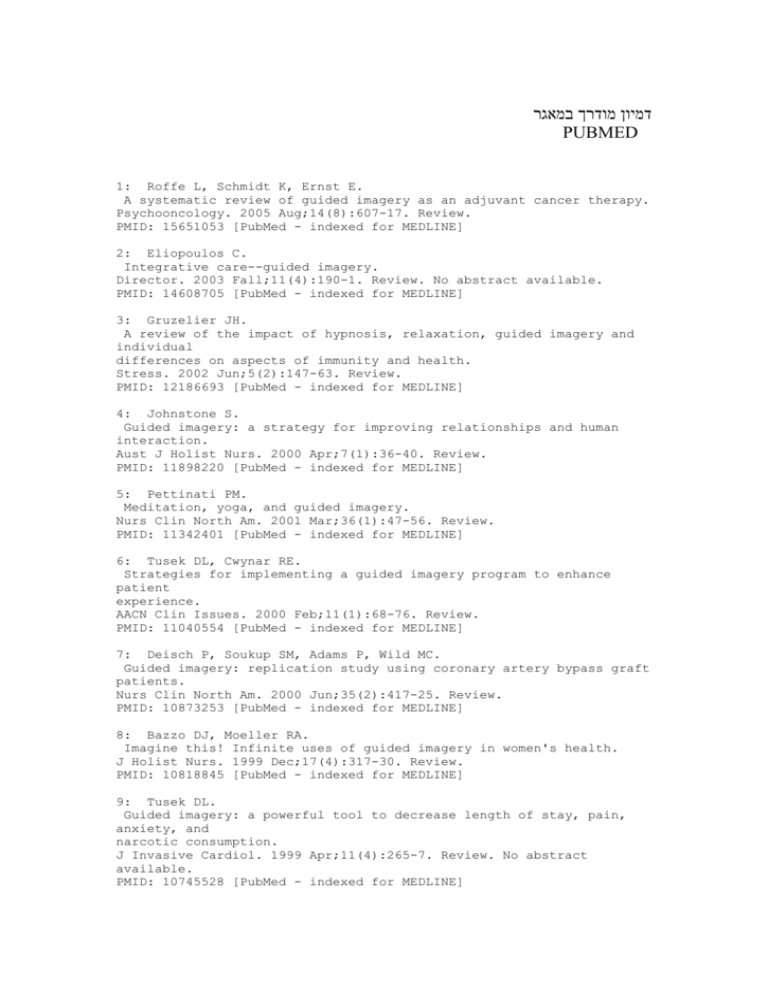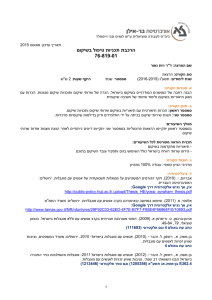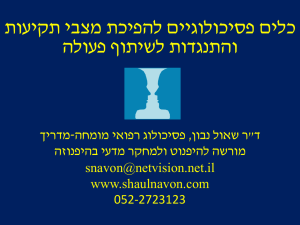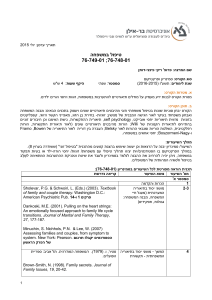
דמיון מודרך במאגר
PUBMED
1: Roffe L, Schmidt K, Ernst E.
A systematic review of guided imagery as an adjuvant cancer therapy.
Psychooncology. 2005 Aug;14(8):607-17. Review.
PMID: 15651053 [PubMed - indexed for MEDLINE]
2: Eliopoulos C.
Integrative care--guided imagery.
Director. 2003 Fall;11(4):190-1. Review. No abstract available.
PMID: 14608705 [PubMed - indexed for MEDLINE]
3: Gruzelier JH.
A review of the impact of hypnosis, relaxation, guided imagery and
individual
differences on aspects of immunity and health.
Stress. 2002 Jun;5(2):147-63. Review.
PMID: 12186693 [PubMed - indexed for MEDLINE]
4: Johnstone S.
Guided imagery: a strategy for improving relationships and human
interaction.
Aust J Holist Nurs. 2000 Apr;7(1):36-40. Review.
PMID: 11898220 [PubMed - indexed for MEDLINE]
5: Pettinati PM.
Meditation, yoga, and guided imagery.
Nurs Clin North Am. 2001 Mar;36(1):47-56. Review.
PMID: 11342401 [PubMed - indexed for MEDLINE]
6: Tusek DL, Cwynar RE.
Strategies for implementing a guided imagery program to enhance
patient
experience.
AACN Clin Issues. 2000 Feb;11(1):68-76. Review.
PMID: 11040554 [PubMed - indexed for MEDLINE]
7: Deisch P, Soukup SM, Adams P, Wild MC.
Guided imagery: replication study using coronary artery bypass graft
patients.
Nurs Clin North Am. 2000 Jun;35(2):417-25. Review.
PMID: 10873253 [PubMed - indexed for MEDLINE]
8: Bazzo DJ, Moeller RA.
Imagine this! Infinite uses of guided imagery in women's health.
J Holist Nurs. 1999 Dec;17(4):317-30. Review.
PMID: 10818845 [PubMed - indexed for MEDLINE]
9: Tusek DL.
Guided imagery: a powerful tool to decrease length of stay, pain,
anxiety, and
narcotic consumption.
J Invasive Cardiol. 1999 Apr;11(4):265-7. Review. No abstract
available.
PMID: 10745528 [PubMed - indexed for MEDLINE]
10: Langley P.
Guided imagery: a review of effectiveness in the care of children.
Paediatr Nurs. 1999 Apr;11(3):18-21. Review. No abstract available.
PMID: 10542592 [PubMed - indexed for MEDLINE]
11: Eller LS.
Guided imagery interventions for symptom management.
Annu Rev Nurs Res. 1999;17:57-84. Review.
PMID: 10418653 [PubMed - indexed for MEDLINE]
12: Hatler CW.
Using guided imagery in the emergency department.
J Emerg Nurs. 1998 Dec;24(6):518-22. Review. No abstract available.
PMID: 9836812 [PubMed - indexed for MEDLINE]
13: Esplen MJ, Garfinkel PE.
Guided imagery treatment to promote self-soothing in bulimia
nervosa. A
theoretical rationale.
J Psychother Pract Res. 1998 Spring;7(2):102-18. Review.
PMID: 9527955 [PubMed - indexed for MEDLINE]
14: Brown-Saltzman K.
Replenishing the spirit by meditative prayer and guided imagery.
Semin Oncol Nurs. 1997 Nov;13(4):255-9. Review.
PMID: 9392033 [PubMed - indexed for MEDLINE]
15: Giedt JF.
Guided Imagery. A psychoneuroimmunological intervention in holistic
nursing
practice.
J Holist Nurs. 1997 Jun;15(2):112-27. Review.
PMID: 9165802 [PubMed - indexed for MEDLINE]
16: Turkoski B, Lance B.
The use of guided imagery with anticipatory grief.
Home Healthc Nurse. 1996 Nov;14(11):878-88. Review.
PMID: 9060286 [PubMed - indexed for MEDLINE]
17: Ott MJ.
Imagine the possibilities! Guided imagery with toddlers and preschoolers.
Pediatr Nurs. 1996 Jan-Feb;22(1):34-8. Review.
PMID: 8700623 [PubMed - indexed for MEDLINE]
18: King JV.
A holistic technique to lower anxiety: relaxation with guided
imagery.
J Holist Nurs. 1988;6(1):16-20. Review. No abstract available.
PMID: 3047225 [PubMed - indexed for MEDLINE]
מאמרים העוסקים ב
Imagery in psychotherapy.
1: Lindauer RT, van Meijel EP, Jalink M, Olff M, Carlier IV, Gersons
BP.
Heart rate responsivity to script-driven imagery in posttraumatic
stress
disorder: specificity of response and effects of psychotherapy.
Psychosom Med. 2006 Jan-Feb;68(1):33-40.
PMID: 16449409 [PubMed - in process]
2: Pickett E.
Programme development. Imagery psychotherapy in head trauma
rehabilitation.
Brain Inj. 1991 Jan-Mar;5(1):33-41.
PMID: 2043906 [PubMed - indexed for MEDLINE]
3: Morrison JK, Becker RE, Heeder R.
Reduction of anxiety: comparative effectiveness of imagery
psychotherapy vs
self-help seminars.
Psychol Rep. 1983 Oct;53(2):417-8. No abstract available.
PMID: 6647689 [PubMed - indexed for MEDLINE]
4: Morrison JK, Becker RE, Heeder R.
Individual imagery psychotherapy vs didactic self-help seminars:
comparative
effect on problem behaviors.
Psychol Rep. 1983 Jun;52(3):709-10. No abstract available.
PMID: 6878566 [PubMed - indexed for MEDLINE]
5: Morrison JK, Becker RE, Isaacs K.
Comparative effectiveness of individual imagery psychotherapy vs
didactic
self-help seminars.
Psychol Rep. 1981 Dec;49(3):923-8. No abstract available.
PMID: 7330153 [PubMed - indexed for MEDLINE]
6: Tress W.
[Guided affective imagery and anxiety control: a comparison of two
specific
factors of effect in psychotherapy (author's transl)]
Psychother Psychosom Med Psychol. 1981 Sep;31(5):156-61. German. No
abstract
available.
PMID: 7346877 [PubMed - indexed for MEDLINE]
7: Wachter HM, Pudel V.
[Controlled examination of an extremely short psychotherapy (15
hours) with
guided affective imagery (author's transl)]
Psychother Psychosom Med Psychol. 1980 Sep;30(5):193-205. German. No
abstract
available.
PMID: 6999523 [PubMed - indexed for MEDLINE]
8: Schoettle UC.
Guided imagery--a tool in child psychotherapy.
Am J Psychother. 1980 Apr;34(2):220-7.
PMID: 7386693 [PubMed - indexed for MEDLINE]
9:
Kulessa C, Jung F.
[The efficiency of 20 hours of brief psychotherapy with the Guidire
Affective
Imagery. Examination with psychological tests]
Z Psychosom Med Psychoanal. 1979 Jul-Sep;25(3):274-93. German.
PMID: 494839 [PubMed - indexed for MEDLINE]
10: Roth JW.
[Guided affective imagery as a method of short-term psychotherapy in
psychosomatic gynecology (author's transl)]
Schweiz Rundsch Med Prax. 1976 Mar 2;65(9):252-6. German. No abstract
available.
PMID: 943784 [PubMed - indexed for MEDLINE]
11: Morishige H, Reyher J.
Alpha rhythm during three conditions of visual imagery and emergent
uncovering
psychotherapy: the critical role of anxiety.
J Abnorm Psychol. 1975 Oct;84(5):531-8. No abstract available.
PMID: 1194513 [PubMed - indexed for MEDLINE]
12: Sheikh AA, Panagiotou NC.
Use of mental imagery in psychotherapy: a critical review.
Percept Mot Skills. 1975 Oct;41(2):555-85.
PMID: 241971 [PubMed - indexed for MEDLINE]
13: Uberto SR.
[Special characteristics of psychotherapy by directed day-dreaming
(L. Rigo's
deep imagery) and its position among mental imagery technics (1969)]
Riv Sper Freniatr Med Leg Alien Ment. 1970 Oct 31;94(5):1336-8.
French. No
abstract available.
PMID: 5497085 [PubMed - indexed for MEDLINE]
14: Rigo L.
[Notes on a T-group conducted with "mental imagery" technics and
non-verbal
psychotherapy]
Riv Sper Freniatr Med Leg Alien Ment. 1970 Jun 30;94(3):589-636.
Italian. No
abstract available.
PMID: 5517398 [PubMed - indexed for MEDLINE]
15: Rabassini A.
[Comparative observations on methods of psychotherapy with mental
imagery, the
directed daydream of Desoille, the Rigo imaginative technic of
psychotherapy and
Jung's active imagination]
Riv Sper Freniatr Med Leg Alien Ment. 1969 Dec;93(6):1360-76.
Italian. No
abstract available.
PMID: 5403602 [PubMed - indexed for MEDLINE]
16: Rigo L.
[On some phenomena and psychophysiological conditions in the course
of the
preparatory and oneirotherapeutic phases of psychotherapy with
"mental imagery"]
Riv Sper Freniatr Med Leg Alien Ment. 1969 Dec;93(6):1344-59.
Italian. No
abstract available.
PMID: 5403601 [PubMed - indexed for MEDLINE]
17: Leuner H.
Guided affective imagery (GAI). A method of intensive psychotherapy.
Am J Psychother. 1969 Jan;23(1):4-21. No abstract available.
PMID: 4180780 [PubMed - indexed for MEDLINE]
18: LEUNER H.
[Experimental catathymic imagery as a clinical procedure of
psychotherapy. I.]
Z Psychother Med Psychol. 1955 Sep;5(5):185-203. German. No abstract
available.
PMID: 13300611 [PubMed - OLDMEDLINE for Pre1966]
ומאמרים מהמאגר
PsychInfo
TITLE: Little pictures in the mind? Everything you need to know about imagery.
PUBLICATION YEAR: 2004
LANGUAGE: English
AUTHOR: Davis,-Stephen-F
SOURCE: PsycCRITIQUES-. Vol 49 (Suppl 8) 2004, No Pagination Specified.
DOCUMENT TYPE: Review
ABSTRACT: Reviews the text "Little Pictures in the Mind? Everything You Need to Know
About Imagery" (see record 2004-16013-000). The large amount of print space currently
being afforded to imagery in psychology suggests the need for a reference and resource work
to consolidate and organize information in this area. The present 771-page volume seeks to
fill that void. The author observes that a total of only 6 articles on imagery in psychology
appeared between 1887 and 1900, whereas over 4,125 articles dealing with imagery
appeared in print between 1991 and 2003; Additionally, a substantial number of books on the
topic of imagery also have appeared. The authors are quoted indicating that "the present
book was written for those laypersons, teachers, students, and researchers who are
interested in gaining a twenty-first-century state-of-the art appreciation of imagery in
psychology" (p. xiii). A strong point of this book is its thorough list of references. The reviewer
further asserts that if the author has not included each and every reference pertaining to
imagery in psychology, he has come very close.
TITLE: Expanding the Cognitive Therapy Model: Imagery, Meditation, and Hypnosis.
PUBLICATION YEAR: 2004
LANGUAGE: English
AUTHOR: Dowd,-E.-Thomas
E-MAIL-AUTHOR: Dowd, E. Thomas: edowd@kent.edu
SOURCE: Journal-of-Cognitive-Psychotherapy. Vol 18(4) Win 2004, 351-359.
DOCUMENT TYPE: Original-Journal-Article
ABSTRACT: This article describes various types of imagery-based interventions, including
meditation, variations of imagery, and hypnosis. Comparisons and contrasts are made among
the different techniques developed over the years and examples of each are given. The
techniques are conceptually based on a model of individual differences in hypnotic ability or
susceptibility. Implications for therapeutic practice are discussed. (PsycINFO Database
Record (c) 2005 APA, all rights reserved) (journal abstract)
העת נמצא באונ' חיפה ובטכניון-כתב
TITLE: Imagery in psychotherapy.
PUBLICATION YEAR: 2006
LANGUAGE: English
AUTHOR: Singer,-Jerome-L
BOOK SOURCE: (2006). Washington, DC, US: American Psychological Association. ix, 225
pp.
ABSTRACT: (from the book) This book guides the practicing clinician or student therapist
toward practical applications of imagery in a range of psychodynamic, cognitive, and
behavioral therapies. Jerome L. Singer builds on the current status of research on
consciousness, narrative thought, and the human capacity for imagery representations of
memories, plans, and fantasies. He draws on his more than 50 years of empirical research
and psychotherapy practice as well as his personal introspections to suggest how clinicians
can expand their own conscious thought and use the gift of imagery to assist patients in
varied clinical approaches. The book emphasizes the common features of psychotherapies
and seeks to demonstrate how clinical practice can be based on fundamental psychological
research in cognition, emotion, and interpersonal transactions using imagery as a focal area.
(PsycINFO Database Record (c) 2006 APA, all rights reserved)
MAJOR DESCRIPTORS: *Imagery-; *Psychotherapeutic-Processes; *PsychotherapyMINOR DESCRIPTORS: Behavior-Therapy; Cognitive-Therapy; PsychodynamicPsychotherapy
TABLE OF CONTENTS: Acknowledgments
* Why Imagery, Personal Memories, and Daydreams Matter / Jerome L. Singer / 3-14
* Experiencing and Communicating Private Imagery: A Significant Human Capability / Jerome
L. Singer / 15-24
* Consciousness, Thinking Modalities, and Imagination: Theory and Research / Jerome L.
Singer / 25-52
* Imagery as a Precursor and Central Component of Narrative Thought / Jerome L. Singer /
53-65
* Imagery and Narrative in Various Forms of Modern Psychotherapy / Jerome L. Singer / 6780
* The Psychotherapeutic Situation / Jerome L. Singer / 81-88
* Using Imagery in Psychoanalytically Oriented Therapies / Jerome L. Singer / 89-103
* Imagery Applications in Cognitive-Behavioral Therapies / Jerome L. Singer / 105-128
* Toward Research-Based New Psychotherapy Models: Self-System and Successful
Intelligence Approaches / Jerome L. Singer / 129-159
* Expanding Imagery in Patient and Therapist / Jerome L. Singer / 161-186
TITLE: Neural Circuits Underlying Emotional Distress in Humans.
PUBLICATION YEAR: 2004
LANGUAGE: English
AUTHOR: Sinha,-Rajita; Lacadie,-Cheryl; Skudlarski,-Pawel; Wexler,-Bruce-E
E-MAIL-AUTHOR: Sinha, Rajita: Rajita.sinha@yale.edu
BOOK SOURCE: Yehuda, Rachel (Ed); McEwen, Bruce (Ed). (2004). Biobehavioral stress
response: Protective and damaging effects. (pp. 254-257). New York, NY, US: New York
Academy of Sciences. xvi, 331 pp.
DOCUMENT TYPE: Original-Chapter
ABSTRACT: (from the chapter) Difficulties in the experiences and regulation of emotional
stress have been associated with the development of psychiatric and substance use
disorders. This study examined neural circuits underlying emotional distress in healthy
volunteers using functional magnetic resonance imaging (fMRI) techniques. Recall of
personal nontraumatic, highly stressful life events with script-driven guided imagery was used
to induce moderate levels of emotional distress in eight healthy volunteers. Subjects
participated in six guided imagery trials (3 separate stress and 3 separate neutral-relaxing
scripts each) interspersed by rest periods in a 1.5T scanner. Results indicated significant
activation in the medial prefrontal, anterior cingulate, caudate, putamen, thalamus,
hippocampus, parahippocampal gyrus, and posterior cingulate regions during emotional
distress relative to brain activation during neutral-relaxing imagery. These findings suggest
that specific striatal-limbic-prefrontal cortical circuits are involved in the experience and
regulation of emotional stress in humans. The study also provides a feasible method to study
brain correlates of emotional stress processing in healthy individuals and clinical samples.
TITLE: Correlation of EEG activity with subjective performance on a guided imagery
test: An exploratory study.
PUBLICATION YEAR: 2004
LANGUAGE: English
AUTHOR: Overton,-James-Alexander-G
E-MAIL-AUTHOR: Overton, James Alexander G.: jamesoverton@kaizen-center.com
SOURCE: Journal-of-Mental-Imagery. Vol 28(1-2) Spr-Sum 2004, 17-60.
DOCUMENT TYPE: Original-Journal-Article
ABSTRACT: The purpose of this study is to advance a neurocognitive investigation of clinical
techniques that rely on the manipulation of the patient's imagination, such as guided imagery
and therapeutic hypnosis, within the context of a more encompassing theory of imaged
experience or "imaginoception." The pilot study investigated the potential relationship
between reported vividness of imagery during a guided imagery task (including visual,
olfactory, auditory, tactile and motor imagery), and activity in the electroencephalograph
(EEG) power spectra, specifically in the theta band. EEG was recorded from 18 subjects
during three intervals: a 3-minute pre-task interval, a 3-minute guided imagery interval (i.e.,
the "task" interval), and a 3-minute post-task interval. Results show very high correlations
between vividness of imagery and levels of frontal midline (Fm) theta power in both the 3minute pre-task (R = 0.8857) and task (R = 0.8837) intervals, and with total theta power (sum
of theta power recorded in 15 channels) (R = 0.9257 and R = 0.8334, respectively). These
results may indicate that the neural mechanisms associated with the production of Fm-theta
in particular, and theta rhythms in general, play a role in the creation of vivid dynamic
imagery. Furthermore, they may be suggestive of general cerebral processes related to the
production of imaginoception
NLP
1: Fluteau JP.
[Flexibility and training. Flexibility of the staff. Beginning with
neuro-linguistic programming]
Soins Form Pedagog Encadr. 1996;(19):21-4. French. No abstract
available.
PMID: 8945428 [PubMed - indexed for MEDLINE]
2: Buteau RA.
[Neuro-linguistic programming. Support in the helping relationship]
Soins Psychiatr. 1994 May;(163):35-42. French. No abstract available.
PMID: 7809727 [PubMed - indexed for MEDLINE]
3: Jepsen CH.
Neutralize dental fear with neuro-linguistic programming.
J Dent Pract Adm. 1988 Jul-Sep;5(3):105-11. No abstract available.
PMID: 3216224 [PubMed - indexed for MEDLINE]
4:
Perren-Klingler G.
[Neuro-linguistic programming, a new approach in the physicianpatient
communication]
Rev Med Suisse Romande. 1988 Jan;108(1):67-9. French. No abstract
available.
PMID: 3347800 [PubMed - indexed for MEDLINE]
5: Oldham J.
Neuro Linguistic Programming.
Aust Fam Physician. 1987 Mar;16(3):237-8, 240. No abstract available.
PMID: 3606483 [PubMed - indexed for MEDLINE]
6: [No authors listed]
Neuro-linguistic programming: gaining rapport and getting into sync.
Hosp Guest Relations Rep. 1986 Feb;1(2):8-9. No abstract available.
PMID: 10294380 [PubMed - indexed for MEDLINE]
7: Krugman M, Kirsch I, Wickless C, Milling L, Golicz H, Toth A.
Neuro-linguistic programming treatment for anxiety: magic or myth?
J Consult Clin Psychol. 1985 Aug;53(4):526-30. No abstract available.
PMID: 2863292 [PubMed - indexed for MEDLINE]
8: Boas P.
Neuro linguistic programming--an aid to management.
Aust Health Rev. 1983 Aug;6(3):38-40.
PMID: 10263094 [PubMed - indexed for MEDLINE]
9: Knowles RD.
Building rapport through neuro-linguistic programming.
Am J Nurs. 1983 Jul;83(7):1011-4. No abstract available.
PMID: 6553452 [PubMed - indexed for MEDLINE]
:ספרים מומלצים שתורגמו לעיברית
. עם-אור. הרפייה עצמית. (1988) אליצור ד"ר ב.1
. נורד. (2001) לגלות את הכוח הטמון במוח ולהשתמש בו לשם שינוי. בנדלר ר.2
. מטר. (2005) 'השיבה אל הילדות. בראדשו ג.3
. עם-אור. (1998) השימוש בדמיון מודרך. גראהם ה.4
. עם-אור. (2000) 'כוחו של התת מודע. מרפי ד"ר ג.5
. עם-( אור1995) דמיון מודרך לצורך שינוי. פאנינג פ.6
. מודן. (2003) כוחו המרפא של הדמיון, להיות פרפר. צור ע.7
נורד2001) קולו של מילטון אריקסון. רוזן ס.8
– דפנה ואמירNLP (1998) ספר ללימוד דמיון מודרך ו, תקשורת עם התת מודע. א. רטר ד.9
. רטר
. 'למברו פ, מ. אולמן א1. ירושלים, כרטא.) היפנוזה עצמית1996( ' ט. למברו פ, ' מ. אולמן א.11
. ירושלים, כרטא. ( 'היפנוזה עצמית1996) ט




